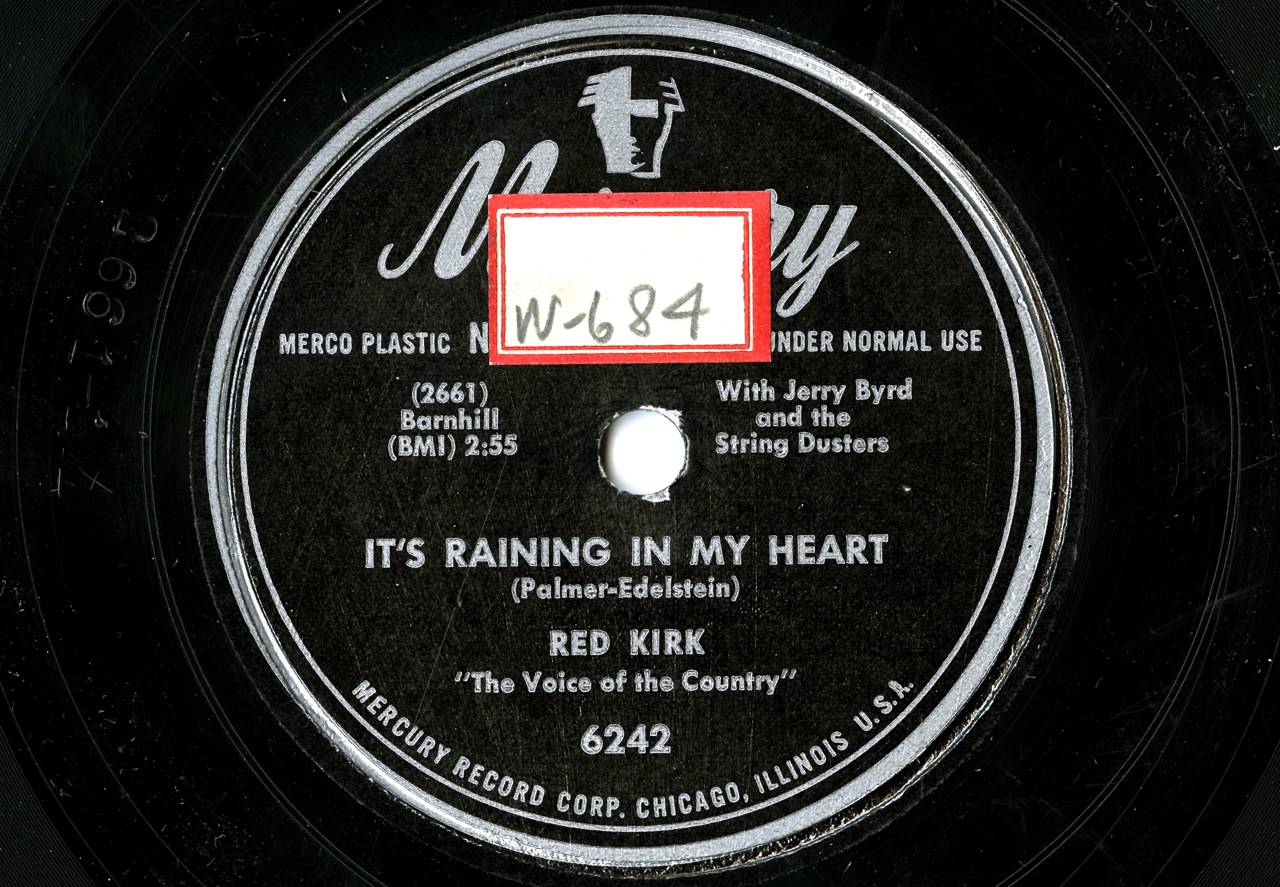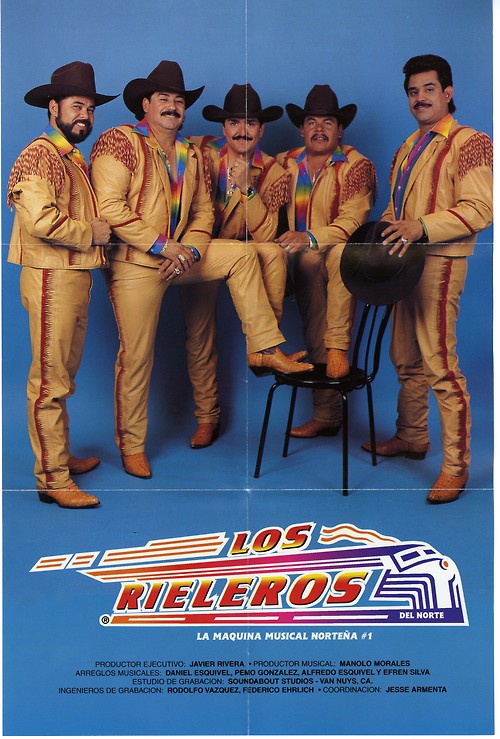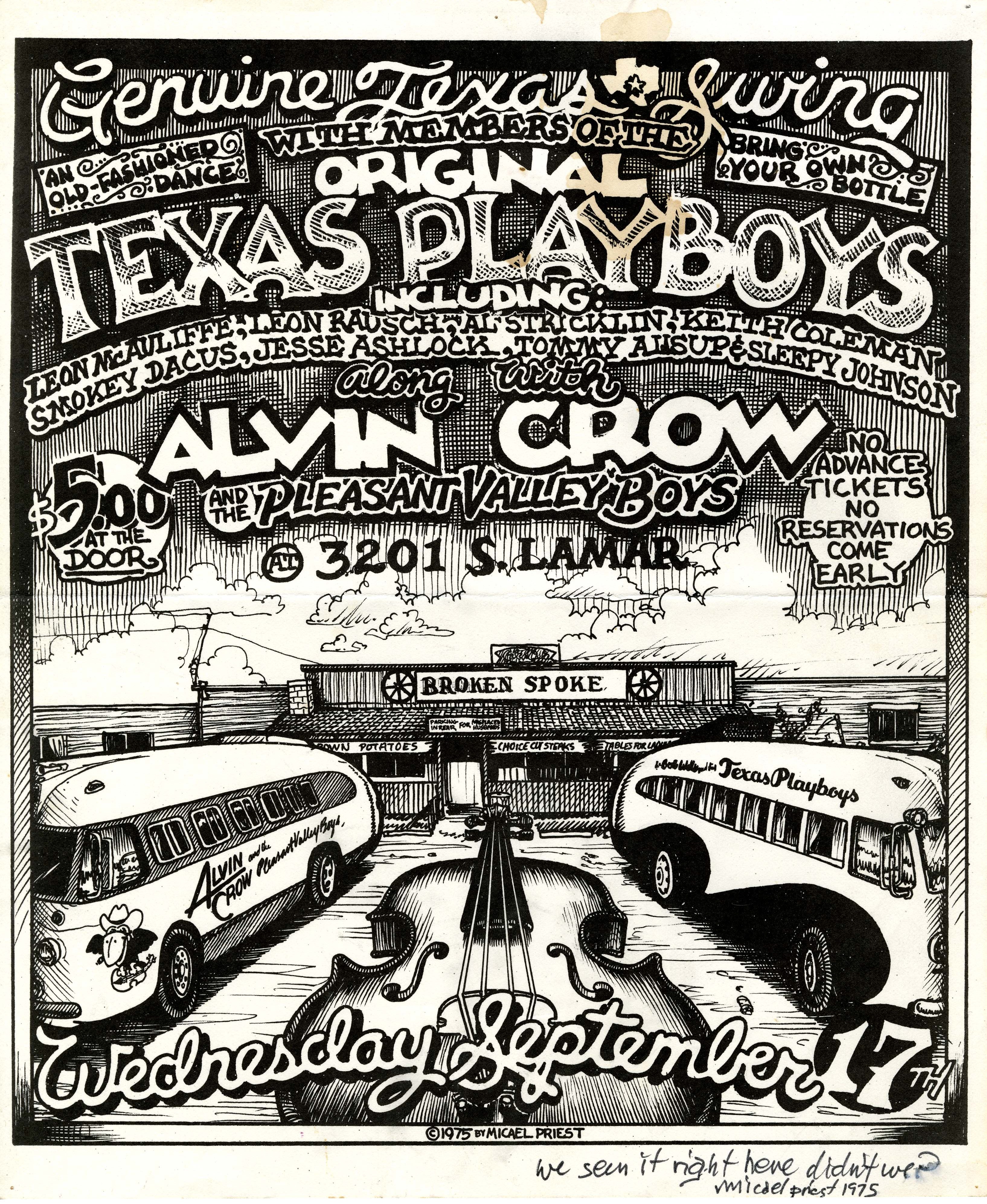 A couple of posters from gigs I would have liked to attend. I was lucky to grow up not 1/2 mile from the Broken Spoke, and despite the best efforts of “New Austin,” I am very glad to report that it’s still there, still honky-tonkin, and the Lone Star is still cold. Both of these posters come from the Archie Green Papers (20002), collected by Archie while a professor at the University of Texas in the 1970s. I feel like artist Michael Priest’s comment written on the bottom of the poster reflects the general sense of wonder those cosmic cowboys and post-hippy hipsters must have felt to be able to attend shows like this on a regular basis, singular moments in music history that transcended the commercial drive of the social scene.
A couple of posters from gigs I would have liked to attend. I was lucky to grow up not 1/2 mile from the Broken Spoke, and despite the best efforts of “New Austin,” I am very glad to report that it’s still there, still honky-tonkin, and the Lone Star is still cold. Both of these posters come from the Archie Green Papers (20002), collected by Archie while a professor at the University of Texas in the 1970s. I feel like artist Michael Priest’s comment written on the bottom of the poster reflects the general sense of wonder those cosmic cowboys and post-hippy hipsters must have felt to be able to attend shows like this on a regular basis, singular moments in music history that transcended the commercial drive of the social scene.
“We seen it right here didn’t we?”
I wish we had, Michael. Long live the kings. 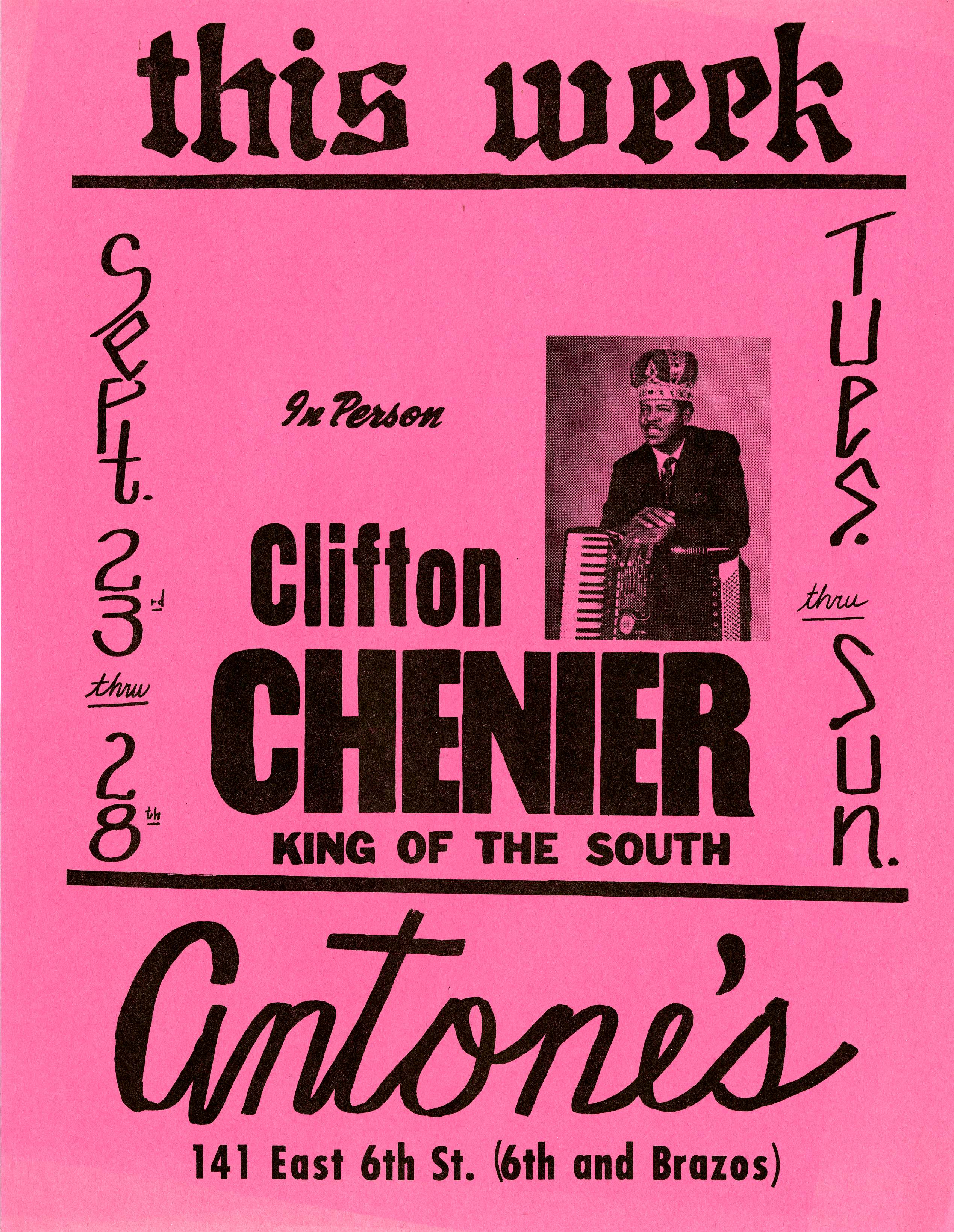
Category: SFC Spotlight
A song of personal thanksgiving

With all of the mythology surrounding contemporary celebrations of Thanksgiving, I often turn to field recordings to guide me through the gauntlet of caricatures that can seem to overwhelm the holiday experience. I like A Charlie Brown Thanksgiving and the Macy’s Parade too, but this time of year always feels surreal until I pull down my collection of Native American music recordings from the record shelf and listen as I begin to prepare dinner for my family and friends.
 Looking through the stacks this morning in the Southern Folklife Collection, I found a Library of Congress collection from the Archive of Folk Song, Songs from the Iroquois Longhouse, SFC call number FC890. Compiled by William Fenton from recordings made for the Bureau of American Ethnology at the Six Nations Reserve in Canada and the Allegany reservation in New York in 1941, the record is a powerful document of music from the Eastern Woodlands of North America.
Looking through the stacks this morning in the Southern Folklife Collection, I found a Library of Congress collection from the Archive of Folk Song, Songs from the Iroquois Longhouse, SFC call number FC890. Compiled by William Fenton from recordings made for the Bureau of American Ethnology at the Six Nations Reserve in Canada and the Allegany reservation in New York in 1941, the record is a powerful document of music from the Eastern Woodlands of North America.
 The notes are extensive and detail the singers, songs, and performance of the music in a variety of contexts. Among the Seneca performers documented is Chancey Johnny John, called hau’no’on, “Cold-voice,” of the Turtle clan of the Cayuga. According to Fenton, Chancey came from a line of singers and knew more than 1000 verses of song. To be able to hear Chancey Johnny John sing is a remarkable gift and we hope you readers and listeners enjoy this short piece as you join together in body, mind, or spirit with your families and friends this weekend. Click on the bar below to listen to Chancey Johnny John recorded in 1941. FC890
The notes are extensive and detail the singers, songs, and performance of the music in a variety of contexts. Among the Seneca performers documented is Chancey Johnny John, called hau’no’on, “Cold-voice,” of the Turtle clan of the Cayuga. According to Fenton, Chancey came from a line of singers and knew more than 1000 verses of song. To be able to hear Chancey Johnny John sing is a remarkable gift and we hope you readers and listeners enjoy this short piece as you join together in body, mind, or spirit with your families and friends this weekend. Click on the bar below to listen to Chancey Johnny John recorded in 1941. FC890
The song of personal thanksgiving is an individual chant sung during the Midwinter festival, on the third day of the Green Corn Festival. According to Fenton, “every man should return thanks to the Creator that he has lived to see the ceremonies again and that so many people have once again returned to renew the faith of their ancestors.” A transcription of the chant follows. 

Dispatch from Cataloger's Corner: Los Rieleros del Norte
Cataloger's Corner: Bluegrass on Blue Ridge Records
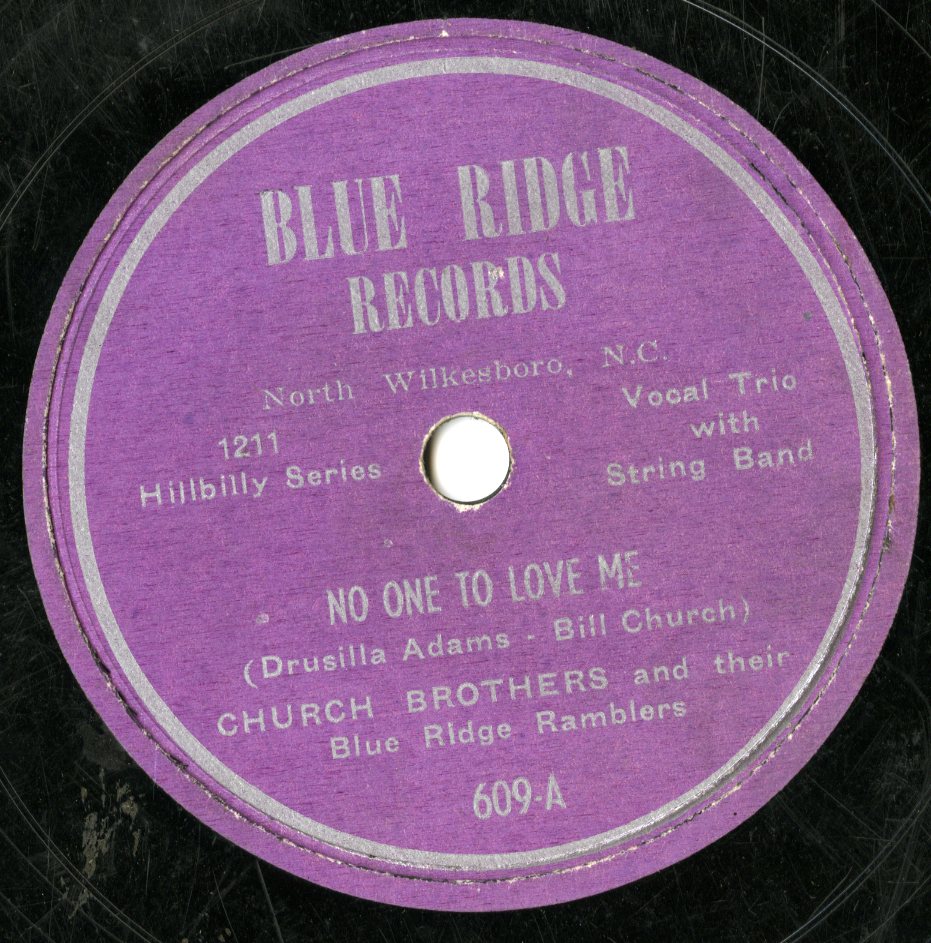
Newly cataloged at the SFC (call no. 78-16864) is a 1952 release by the Church Brothers & their Blue Ridge Ramblers, a short-lived ensemble on a short-lived label, both based out of Wilkes County, North Carolina.
The oldest of the three Church Brothers, Bill Church, had played during the 1940s with Roy Hall & his Blue Ridge Entertainers and on a radio show in Asheville, N.C. called “Farm and Fun Time.” After serving in World War II, he and his brother Ralph began playing with cousin Ward Eller and a few other locals—Drake Walsh (son of Dock Walsh), Gar Bowers and Elmer Bowers. Eventually a third Church brother (Edwin) joined the group. Calling themselves the Wilkes County Entertainers, they played on the local radio stations WILX and WKBC and at schoolhouse shows.

By the 1950s they were performing as the Church Brothers and their Blue Ridge Ramblers and making recordings with a lineup featuring Bill Church (guitar), Edwin Church (fiddle), Ralph Church (mandolin), Ward Eller (guitar), Ralph Pennington (bass), and Johnny Nelson (banjo). They also began recording songs written by a local lyricist, Drusilla Adams. Initially the band planned to have these recordings come out on Rich-R-Tone Records (at the time based in Johnson City, TN). Because of various delays, Drusilla and her father decided expedite the process by setting up their own Wilkesboro-based label called Blue Ridge Records, which issued several Church Brothers singles. Blue Ridge Records went on to record the Stanley Brothers and Bill Clifton; the label lasted until 1958 when Noah Adams passed away and it was sold.
The single “No One to Love Me,” featured here, received a somewhat mixed review from Billboard magazine: “A lively performance by the Church Brothers with hoedown accompaniment of a so-so piece of material.” About the B-side, “You’re Still the Rose of my Heart,” the critic simply stated: “More of the same.”
We’ve provided an excerpt from “No One to Love Me” here: here.
In addition to their releases on Blue Ridge, the Church Brothers & their Blue Ridge Ramblers eventually did go on to sign a contract with Rich-R-Tone, recording several tracks for that label. In 1952, the group disbanded—though the members continued to play on their own at various dance events in the Wilkesboro area.
The Church Brothers’ output on Blue Ridge Records and was later released on LP compilations by Gerd Hadeler Productions and Rounder Records. These LPs are also available at the SFC, as FC-4743 and FC-2046, pictured below.

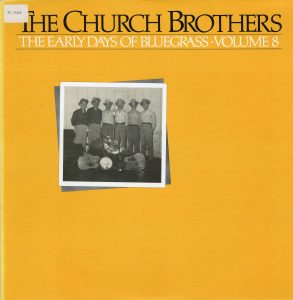
An article and video feature on former Rambler Ward Eller’s experiences with the band appeared in the March 2014 issue of Mountain Music Magazine.
78 of the week: Ida Cox and Lovie Austin on Paramount
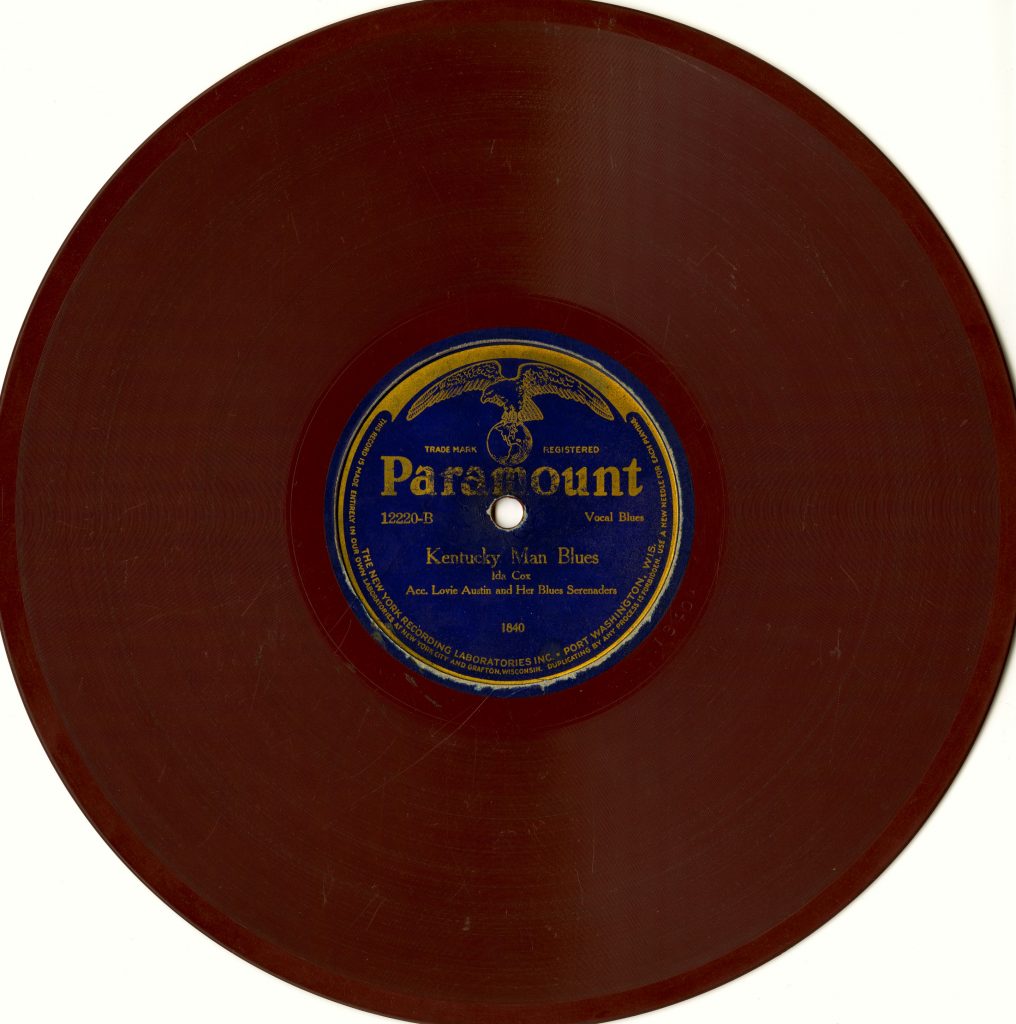 Sorry to be so quiet around here lately. Summer in Chapel Hill may be quiet, but activity at Wilson Library intensifies as the temperature goes up. We’ve got exciting news about the SFC 25 year anniversary coming up so stay tuned to Field Trip South over the next few days. You’re going to love it.
Sorry to be so quiet around here lately. Summer in Chapel Hill may be quiet, but activity at Wilson Library intensifies as the temperature goes up. We’ve got exciting news about the SFC 25 year anniversary coming up so stay tuned to Field Trip South over the next few days. You’re going to love it.
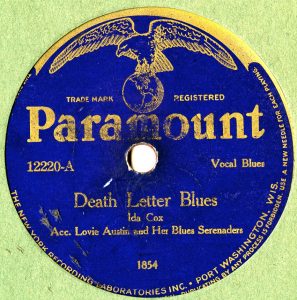 But for this afternoon, to ease back into blogging this week I thought we could start slow with call no. 78-11107 by the remarkable Ida Cox accompanied by the one and only Lovie Austin. “Death Letter Blues” and “Kentucky Man Blues” are but two of 78 sides Cox recorded for Paramount between 1923 and 1929. Enjoy these segments, presented with no noise reduction or post-processing. Love the sound.78_11107_Ida_Cox_Death_Letter_Blues 78_11107_Ida_Cox_Kentucky_Man_Blues
But for this afternoon, to ease back into blogging this week I thought we could start slow with call no. 78-11107 by the remarkable Ida Cox accompanied by the one and only Lovie Austin. “Death Letter Blues” and “Kentucky Man Blues” are but two of 78 sides Cox recorded for Paramount between 1923 and 1929. Enjoy these segments, presented with no noise reduction or post-processing. Love the sound.78_11107_Ida_Cox_Death_Letter_Blues 78_11107_Ida_Cox_Kentucky_Man_Blues
Southern Folklife Collection Flamenco photo of the week

Stunning photographs made by Aaron Rennert for Photo-Sound Associates, from the Ron Cohen Collection (20239). Shot in New York City, in the late 1950s, the images document a party attended by members of the famed Ballet Español de Ximenez-Vargas. Dancers include (from top to bottom): Carmen Rivas, an unidentified man, Maria Alba (Flamenco dance star who studied with Mariquita Flores and by 1957 or so was dancing with Ximenez-Vargas), and Antonio Hector de Jesus.
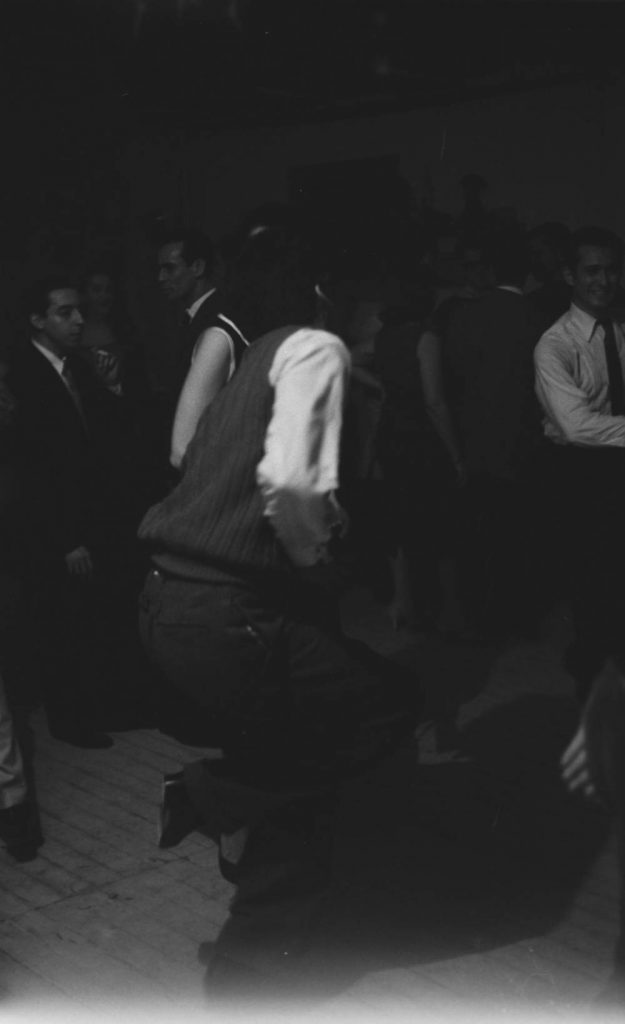

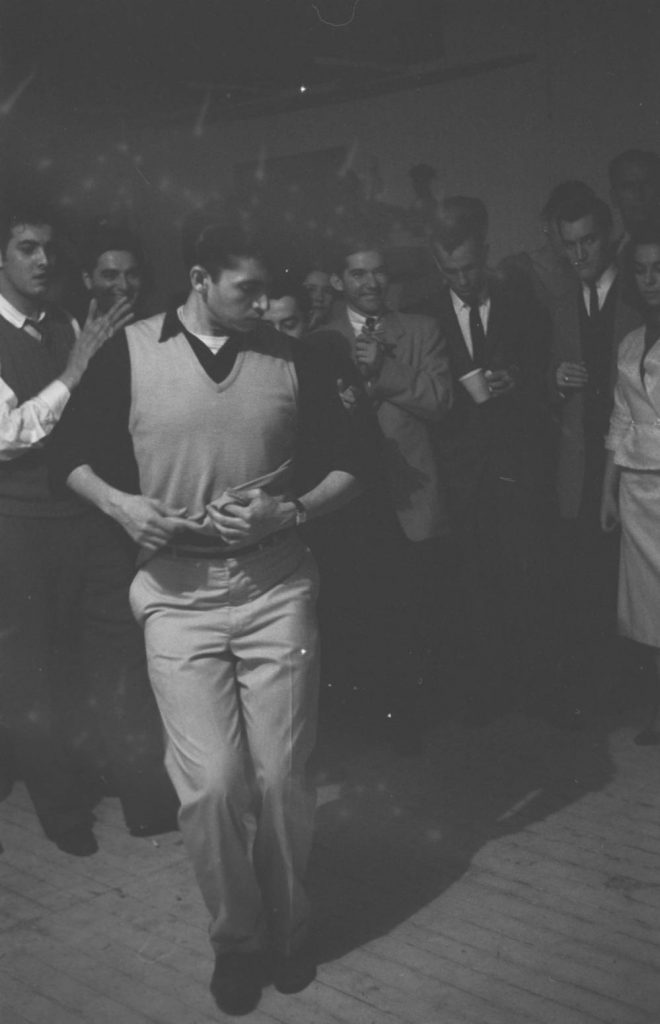
Ham, corn and fiddle tunes at Tommy Jarrell's
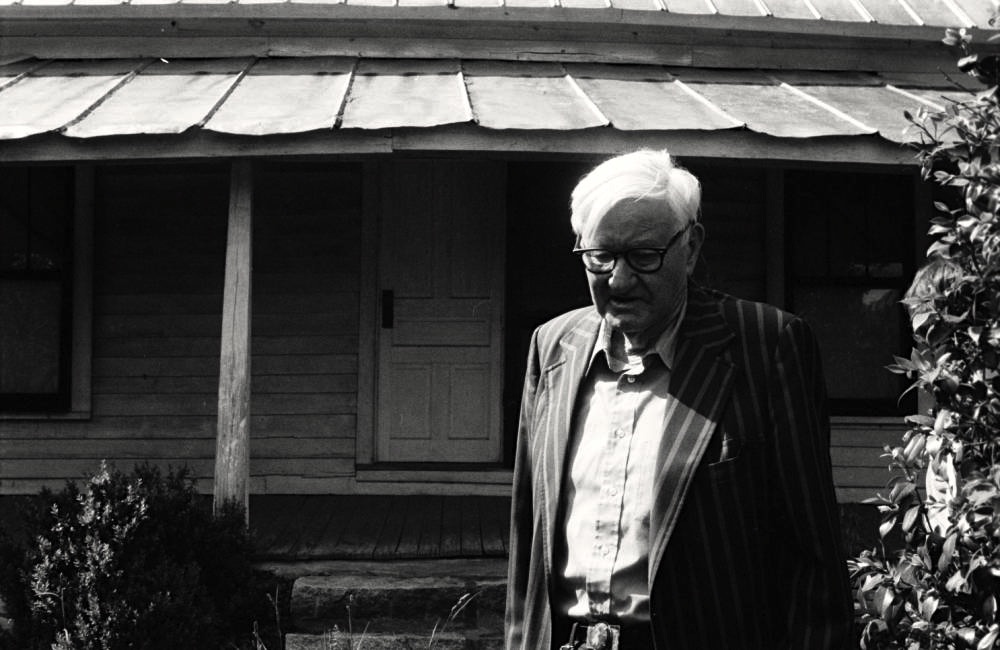 Back in 2009 we wrote about a field recording, call no. FS8341 from the Alice Gerrard Collection, documenting the Christmas she and Andy Cahan spent with Tommy Jarrell and his daughter Dena in 1983. For those who are interested, they had chicken and “it was so fine.”
Back in 2009 we wrote about a field recording, call no. FS8341 from the Alice Gerrard Collection, documenting the Christmas she and Andy Cahan spent with Tommy Jarrell and his daughter Dena in 1983. For those who are interested, they had chicken and “it was so fine.”
That’s not the only holiday recording in the Alice Gerrard Collection. FS8205 was made in 1981 when Alice and a few others, including old-time musician Rusty Neithammer, spent Thanksgiving with Tommy. They had ham, and also some corn, according to the tape.FS8205_Ham
How many other holiday menus and recipes were recorded in the process of doing field work that are now held in Wilson Library at UNC? These recordings and thousands more are available for research in the Southern Folklife Collection. There was quite a bit of music at that Thanksgiving celebration, listen to Jarrell’s solo banjo version of “Let Me Fall” and then Rusty Neithammer and Tommy Jarrell twin fiddle one of my favorites, “Rockingham Cindy.”FS8205_Let Me Fall_BanjoFS8205_Rockingham Cindy
The Southern Folklife Collection is thankful to be able to share this with all of you out there. Happy Thanksgiving.
SFC Spooky Spotlight: A "Mummie's Curse" uncovered in the Goldband Recording Corporation Collection
 With the Wilson Library live action Clue Game happening tonight and All Hallow’s Eve tomorrow, it’s no surprise that strange phenomena have been occuring in the Southern Folklife Collection studios. Just this morning, preservation audio engineer Brian Paulson digitized the Goldband Records master tape of Satan and the Deciples, call no. FT6891 in the Goldband Recording Corporation Collection (20245), as part of our current digitization project, From the Piedmont to the Swamplands: Preserving Southern Traditional Music.
With the Wilson Library live action Clue Game happening tonight and All Hallow’s Eve tomorrow, it’s no surprise that strange phenomena have been occuring in the Southern Folklife Collection studios. Just this morning, preservation audio engineer Brian Paulson digitized the Goldband Records master tape of Satan and the Deciples, call no. FT6891 in the Goldband Recording Corporation Collection (20245), as part of our current digitization project, From the Piedmont to the Swamplands: Preserving Southern Traditional Music.
 Brian arrived to work this morning, having left the Rivers Studio in proper order when he left last night, to find this open reel tape spooled on the Otari ready for playback. No one knows how the tape got from the stacks to the studio or what could have loaded the tape onto the machine. Not one to question the will and ways of the supernatural, of course Brian played the tape, reavealing the following horrifying song, “Mummie’s Curse.”FT6891_ Satan and Deciples_Mummie’s Curse_Goldband Recording Corporation Collection (20245)_Southern Folklife CollectionNot much is known about Satan and the Deciples (aka Satan and Satin’s Roses, aka Satin and the Deciples). The theory we agreed upon in the Rivers Studio accepts that the band rose out of the swamps around Lake Charles, called from eternal slumber to terrorize the honky-tonks of East Texas like so many of the undead. Other more likely theories suggest the band was a novelty project made up of a crew of local bar band musicians that liked scary movies. Considering the Deciples featured one Baldemar Huerta (aka Freddy Fender who co-wrote both tracks on this tape) on lead guitar, the latter theory is more plausible. We may never know the truth, but we were inspired to pull out Jason Lonon’s poster for a “Halloween Ho-down” (featured above) to share with you fine readers, call no. OP-20451/16 from the Jason Lonon Poster Collection (20451).
Brian arrived to work this morning, having left the Rivers Studio in proper order when he left last night, to find this open reel tape spooled on the Otari ready for playback. No one knows how the tape got from the stacks to the studio or what could have loaded the tape onto the machine. Not one to question the will and ways of the supernatural, of course Brian played the tape, reavealing the following horrifying song, “Mummie’s Curse.”FT6891_ Satan and Deciples_Mummie’s Curse_Goldband Recording Corporation Collection (20245)_Southern Folklife CollectionNot much is known about Satan and the Deciples (aka Satan and Satin’s Roses, aka Satin and the Deciples). The theory we agreed upon in the Rivers Studio accepts that the band rose out of the swamps around Lake Charles, called from eternal slumber to terrorize the honky-tonks of East Texas like so many of the undead. Other more likely theories suggest the band was a novelty project made up of a crew of local bar band musicians that liked scary movies. Considering the Deciples featured one Baldemar Huerta (aka Freddy Fender who co-wrote both tracks on this tape) on lead guitar, the latter theory is more plausible. We may never know the truth, but we were inspired to pull out Jason Lonon’s poster for a “Halloween Ho-down” (featured above) to share with you fine readers, call no. OP-20451/16 from the Jason Lonon Poster Collection (20451).
Happy Halloween.
78 of the week: Jesse Rodgers with Kama's Moana Hawaiians
 78_828_San Antonio Blues_Southern Folklife Collection
78_828_San Antonio Blues_Southern Folklife Collection
Two excellent sides for you by the great Jesse Rodgers (first cousin to Jimmie), from Southern Folklife Collection disc call no. 78-828. A successful musician who appeared on the “border-blaster” radio stations XERA and XERN in the late 20s and early 30s, Rodgers career took off in an unexpected direction after Jimmie’s untimely death in 1933. Always looking to repeat past successes, RCA-Bluebird picked up Jesse in hopes he would continue where Jimmie left off, even setting Jesse up to record with the great steel guitarist Charles Kama and his Moana Hawaiians who had recorded previous sides with Jimmie. These two tracks were recorded 28 Feburary 1936 at the Texas Hotel in San Antonio. Kama’s guitar work is superb and his musical arrangement wonderfully compliments the tune. Listen to the solo in the second clip below and note Kama’s masterful accompaniment to Rodger’s blue yodeling. Fantastic. 78_828_Old Pinto, My Pony, My Pal_part1 78_828_Old Pinto, My Pony, My Pal_part2

78 rpm disc of the week: Red Kirk "The Voice of the Country"
 78_9938_Why do you care
78_9938_Why do you care
Great pair of pure country tearjerkers from Southern Folklife Collection 78 rpm disc call no. 78-9938. I discovered these numbers thanks to a recent request and gladly spent some time in the studio while the great Red Kirk, known as “The Voice of the Country,” and the phenomenal steel guitar of Jerry Byrd played offered the soundtrack to my morning blues. Recorded in Cincinnati with Jerry Byrd’s String Dusters–Louis Innis on rhythm, Zeke Turner on lead guitar, Red Turner on bass, and Tommy Jackson on fiddle–all great session players that also performed the Midwestern Hayride on WLW. Side two, “It’s Raining in my Heart” is even better.
78_9938_It’s raining in my heart
